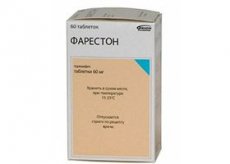Medical expert of the article
New publications
Preparations
Fareston
Last reviewed: 03.07.2025

All iLive content is medically reviewed or fact checked to ensure as much factual accuracy as possible.
We have strict sourcing guidelines and only link to reputable media sites, academic research institutions and, whenever possible, medically peer reviewed studies. Note that the numbers in parentheses ([1], [2], etc.) are clickable links to these studies.
If you feel that any of our content is inaccurate, out-of-date, or otherwise questionable, please select it and press Ctrl + Enter.

Indications Fareston
Fareston is used as a first-line drug in the treatment protocol for metastatic breast cancer in the postmenopausal period.
In addition, the drug can be prescribed for prophylactic and therapeutic purposes for dyshormonal dysplasia of the mammary gland.
Fareston is not used to treat estrogen receptor-negative tumors.
Release form
Fareston is available in tablets of 20 or 60 mg. The tablets are flat-round, light-colored, with the inscription TO 20 or TO 60 on one side (which corresponds to the dosage of the drug).
The active ingredient in Fareston is toremifene citrate.
The tablets are packed in bottles of 30 pieces. The pack is cardboard, with instructions for use inside.
Pharmacodynamics
The active ingredient toremifene is a representative of triphenylethylene and has the property of contacting estrogen receptors and producing a similar or antiestrogenic effect. At the same time, a slight decrease in serum cholesterol levels is observed.
Fareston binds to estrogen receptors and blocks mediated activation of DNA production and the process of cellular replication. Studies have confirmed the estrogen-independent anticancer effect of the drug.
It is possible that not all links of Fareston's anticancer effect have been studied at the moment. Probably, treatment with the drug provokes changes in oncogenic expression, affects the kinetic properties of the cell cycle, etc.
 [ 5 ]
[ 5 ]
Pharmacokinetics
Fareston is well absorbed by the body. The maximum level of the active ingredient in the blood serum is determined after 2-5 hours. The presence of food in the stomach does not affect the absorption of the drug, but the maximum level can be shifted by 90-120 minutes, although this fact has no therapeutic value.
The connection with plasma proteins is 99.5%.
The metabolism of the active ingredient is quite intensive. It is excreted from the body in the form of residual products with feces, and only up to 10% is excreted by the kidneys.
A stable level of the drug in the blood is observed for approximately 5 weeks.
Dosing and administration
Fareston is taken orally, at any time, regardless of food intake.
- For dyshormonal dysplasia of the mammary gland, 20 g of the drug is prescribed per day.
- For estrogen-dependent breast cancer, 60 mg per day is prescribed.
- In case of insufficient renal function, no dosage adjustment is required.
- In case of insufficient liver function, Fareston is prescribed very carefully, and the dosage is selected individually.
Use Fareston during pregnancy
Fareston is prescribed to patients in the postmenopausal period, therefore its use during pregnancy and breastfeeding is not considered or is considered inappropriate.
Contraindications
Absolute contraindications to taking Fareston are endometrial hyperplasia and insufficient liver function.
In addition, Fareston is not prescribed:
- in case of possible allergy to the drug;
- in cardiac pathologies accompanied by prolongation of the QT interval;
- in case of water balance disorders with incorrect hypokalemia;
- in case of severe bradycardia;
- in cardiac pathologies that are accompanied by a decrease in left ventricular output;
- in case of symptomatic cardiac arrhythmia.
Side effects Fareston
Side effects when taking Fareston are not uncommon. The following symptoms may occur:
- a feeling of “hot flashes” accompanied by sweating and redness of the face;
- bleeding and discharge from the vagina;
- feeling of fatigue;
- nausea, dizziness;
- edema, weight gain;
- thrombosis, thrombophlebitis;
- skin rashes;
- depressive states;
- endometrial hypertrophy, hyperplasia, polyps, cancerous neoplasms.
Overdose
Overdose of Fareston may be accompanied by:
- dizziness;
- headaches;
- loss of balance.
Treatment is prescribed according to the symptoms detected, since there is no special drug to eliminate overdose symptoms.
 [ 15 ]
[ 15 ]
Interactions with other drugs
It is prohibited to take Fareston and the following medications at the same time:
- antiarrhythmic drugs;
- neuroleptics;
- Erythromycin, Moxifloxacin, antimalarial drugs, Pentamidine;
- antihistamines Terfenadine or Mizolastine;
- Diphemanil, Vincamine and other medications that may prolong the QT interval.
In addition, other Fareston combinations should be avoided:
- with thiazide diuretics (due to the development of hypercalcemia);
- with Phenobarbital, Carbamazepine (due to the possibility of decreasing the level of toremifene in the bloodstream);
- with antiestrogens and anticoagulants (due to the risk of bleeding);
- with Ketoconazole, antifungal drugs, macrolide antibiotics (due to inhibition of metabolic processes of toremifene).
 [ 16 ]
[ 16 ]
Storage conditions
Fareston is stored in room conditions, excluding children's access to places where medicines are stored.
 [ 17 ]
[ 17 ]
Shelf life
Attention!
To simplify the perception of information, this instruction for use of the drug "Fareston" translated and presented in a special form on the basis of the official instructions for medical use of the drug. Before use read the annotation that came directly to medicines.
Description provided for informational purposes and is not a guide to self-healing. The need for this drug, the purpose of the treatment regimen, methods and dose of the drug is determined solely by the attending physician. Self-medication is dangerous for your health.

